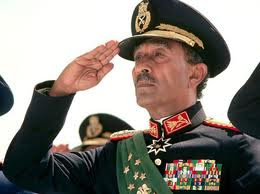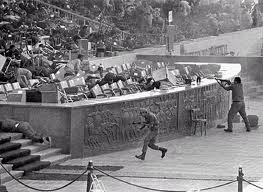 Having offered my assessment of Gamal Abdel Nasser on the 40th anniversary of his death, it may be appropriate today, the 29th anniversary of the assassination of Anwar Sadat, to offer some reflections on Nasser's successor. (And, of course, I offered an appreciation of Egypt's first President, Muhammad Naguib, in July.)
Having offered my assessment of Gamal Abdel Nasser on the 40th anniversary of his death, it may be appropriate today, the 29th anniversary of the assassination of Anwar Sadat, to offer some reflections on Nasser's successor. (And, of course, I offered an appreciation of Egypt's first President, Muhammad Naguib, in July.)Whereas Nasser died before I ever visited the Middle East, I lived in Egypt for two of Sadat's 11 years as President, watched the parade when he returned from the Knesset, and was in Cairo again only a couple of weeks after the assassination. If you had asked me when I first lived in Egypt in 1972 if we would ever see the picture that appears above right, I'd have said not in my lifetime. Yet it happened seven years later. (Sadat, Jimmy Carter, and Menahem Begin, for those of you who weren't born yet.)
October 6 is, as I noted last year, a curious double anniversary in Egypt: Sadat's greatest pride was the crossing of the Suez Canal on October 6, 1973, restoring the honor of Egyptian arms after the debacle of 1967; even if the 1973 war had its reverses as well. October 6 became Egyptian Military Day (it still is), and it was at a Military Day Parade in 1981 that Sadat was assassinated. (Two years later, at an Egyptian Military Day reception at Fort Myer, I met the lady who would become my wife, but that's another story, and off-topic.)
Sadat's legacy is somewhat curious. In life, he had more admirers toward the end in the US than at home. In death, he remains controversial: one's opinion of his opening to peace with Israel is part of it, but his drastic crackdowns on many elements of Egyptian society in his last months have soiled his reputation at home. He was a better diplomat and strategist, perhaps, than executive of Egypt with its many problems and challenges.
One thing for certain: Sadat was interesting in ways that Husni Mubarak is not. He loved the dramatic reversal: purging the Nasserists of the ‘Ali Sabri group (his "Corrective Revolution" of 1971, though some saw it as a counterrevolution), throwing Russian advisors out of Egypt in 1972, launching an attack across the Suez Canal in 1973, shifting to a US alliance in 1974-75 and, of course, offering to go to the Knesset — and then actually going — in 1977, and Camp David in 1979. The assassination of Sadat also marks 29 years of Husni Mubarak's rule, and one has to say that, whatever else, any given year of Sadat held more surprises than all 29 of Mubarak's put together. Of course, that's the stability Mubarak's supporters see as his legacy.
Sadat's success on the international stage may have served as the nemesis that undermined his leadership at home. As Time's Man of the Year, winner of the Nobel Peace Prize, a regular on the American TV networks, Sadat was on a global stage, and like many world leaders, seemed to believe his own publicity. But not all was well. Earlier in 1977 (the year of the trip to the Knesset), major bread riots broke out in Egypt, leading to use of the Army to calm things down, a rare use of the military as opposed to the security services. The first stirrings of radical Islamist violence were being felt. Sadat's infitah or "opening" economically opened up the economy a bit but also encouraged corruption. Domestically, he did not enjoy the success he relished on the international stage.
And the man's style was very different from Nasser's. Nasser always sought to be the man of the people; Sadat preferred some combination of paternalistic village elder (when he went to his home village of Mit Abu'l-Qom, he'd pose in galabiyya, smoking a pipe) and hints of pharaonic splendor.
 Sadat redesigned the dress uniform of senior officers (actually, I think he had Pierre Cardin or someone similar design it) as shown at left. It had some faintly Pharaonic touches, but he also posed with a field marshal's baton with the lotus and papyrus emblems of Upper and Lower Egypt, a distinctly Pharaonic touch. I couldn't find a photo online, however.
Sadat redesigned the dress uniform of senior officers (actually, I think he had Pierre Cardin or someone similar design it) as shown at left. It had some faintly Pharaonic touches, but he also posed with a field marshal's baton with the lotus and papyrus emblems of Upper and Lower Egypt, a distinctly Pharaonic touch. I couldn't find a photo online, however.When his assassins were on trial, his primary assassin publicly boasted "I killed Pharaoh." This was not just a reference to Pharaoh as a monarch: in the Qur'an, Fir‘awn, Pharaoh, symbolizes worldly power and corrupt tyranny, so it has an Islamic as well as an Egyptian reference.
His ego grew with the Nobel Prize and international fame: his autobiography In Search of Identity rewrote the earlier versions of the Free Officers he'd published in the fifties under Nasser, and took more credit for himself. He kept rewriting his own autobiography until I'm not sure he knew the truth himself.
While many Arabs (and Egyptians) still disagree with his opening to Israel, that is not, contrary to the usual assumption in the West, what led to his death (though it was surely part of the mix). In the summer and fall of 1981 he cracked down on all his enemies at once: he jailed the Supreme Guide of the Muslim Brotherhood and also exiled the Coptic Pope to a desert monastery; he jailed Mohammed Hassanein Heikal (who after his death wrote a take-no-prisoners deconstruction of Sadat called Autumn of Fury; it remains the most savage interpretation of the man I know of, and a lesson in why you shouldn't jail journalists). And he was rounding up opposition party heads (even the ancient Fuad Serageddin, King Farouq's last Interior Minister and head of the Wafd Party) and jailing them as well.
 More and more, he appeared in military uniform; in Nasser's later years, he rarely did so.
More and more, he appeared in military uniform; in Nasser's later years, he rarely did so.In the end, in this period of high tension and repression, Sadat was gunned down on the eighth anniversary of his proudest triumph. (Two innocent bystanders were collateral damage: the Omani Ambassador and Coptic Bishop Samweel, head of the interim bishops' council Sadat named to replace the exiled Pope; both were behind him on the reviewing stand and died in the crossfire.)
I noted last week the contrasts between the funerals of Nasser and Sadat. To be fair to the latter, since he died by assassination, the security establishment he had retained from Nasser's day was naturally paranoid (as security establishments tend to be) and did not trust the populace to attend. Two or three weeks later, when I was in Cairo, armored vehicles were still parked around Tahrir Square.
Sadat's historic accomplishments need no apologies: the Canal crossing, the strategic shift to the West, the peace with Israel.
In his own country, his memory is more ambiguous than in the West, but he still has many admirers. And of course, the ending, while memorable, was violent, and one of the more violent early manifestations of Islamist fury.






3 comments:
Mike wrote, "Sadat's historic accomplishments need no apologies: the Canal crossing, the strategic shift to the West, the peace with Israel."
To which I say, Amen! When I was on the faculty of the National Defense University, we identified three foreign statesmen as astute strategists who greatly advanced the national security of their countries: De Gaulle, Chou en-Lai and Sadat. All three were adept at identifying overriding national interests and using the full range of their national assets to advance them. All three punched over their weight.
I lived in Cairo from the summer of 1975 to the summer of 1979 and I got to know Sadat fairly well; I even wrote a book about him, "Egpt After Nasser." I agree with Mike and David, but I would add a few comments. Sadat was a visionary, and like all visionaries he was unable to look back at the wreckage he left behind as he pursued his vision. For example, he made the mistake of encouraging Islamist elements to dominate university campuses because he saw them as a useful antidote to Nasser-style socialism. Sadat was also very entertaining; that's why two of his most severe critics, David Hirst and Irene Beesom, dismissed him in their biography of him as a "mountebank." In their view, he sold out the Palestinians -- end of story-- Tom Lippman
Tom:
Great comment. I love the image of the wreckage visionaries leave behind.
Post a Comment